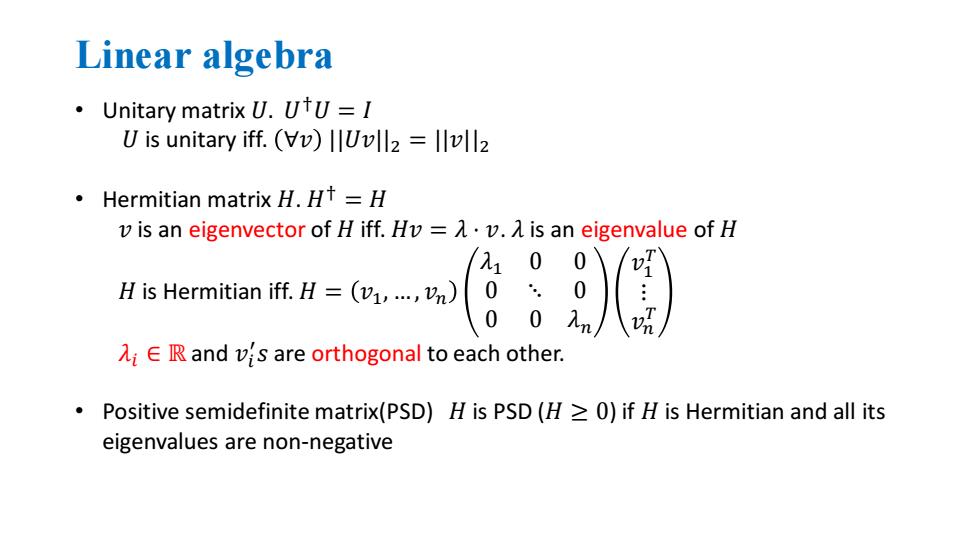
Linear algebra Unitary matrix U.UTU =I U is unitary iff.(V)2=2 Hermitian matrix H.H =H v is an eigenvector of H iff.Hv=1.v.A is an eigenvalue of H 九1 0 0 Hermiian-8置2 Ai E Rand vs are orthogonal to each other. Positive semidefinite matrix(PSD)H is PSD (H>0)if H is Hermitian and all its eigenvalues are non-negative
Linear algebra • Unitary matrix 𝑈. 𝑈 †𝑈 = 𝐼 𝑈 is unitary iff. ∀𝑣 ||𝑈𝑣||2 = ||𝑣||2 • Hermitian matrix 𝐻. 𝐻 † = 𝐻 𝑣 is an eigenvector of 𝐻 iff. 𝐻𝑣 = 𝜆 ⋅ 𝑣. 𝜆 is an eigenvalue of 𝐻 𝐻 is Hermitian iff. 𝐻 = 𝑣1 , … , 𝑣𝑛 𝜆1 0 0 0 ⋱ 0 0 0 𝜆𝑛 𝑣1 𝑇 ⋮ 𝑣𝑛 𝑇 𝜆𝑖 ∈ ℝ and 𝑣𝑖 ′ 𝑠 are orthogonal to each other. • Positive semidefinite matrix(PSD) 𝐻 is PSD (𝐻 ≥ 0) if 𝐻 is Hermitian and all its eigenvalues are non-negative
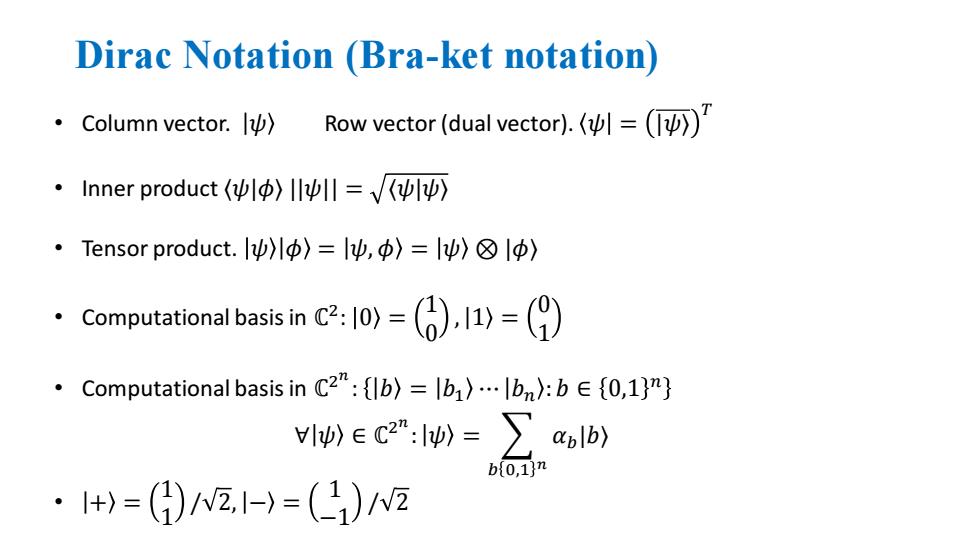
Dirac Notation (Bra-ket notation) ·Column vector..ly) Row vector(dual vector).(= ·Inner product(lp)lll=√lp) ·Tensor product.l)川p)=l中,φ〉=lψ〉☒lφ) .Computational basis in 2:=(=0 Computational basis in C2":lb〉=lb1)…lbn:b∈{0,1}ry lp)∈c2”:I〉=>ab) b0,1]n ·+)=()W2,-)=(1)N2
Dirac Notation (Bra-ket notation) • Column vector. 𝜓 Row vector (dual vector). 𝜓 = |𝜓⟩ 𝑇 • Inner product ⟨𝜓|𝜙⟩ ||𝜓|| = ⟨𝜓|𝜓⟩ • Tensor product. 𝜓 𝜙 = 𝜓,𝜙 = 𝜓 ⊗ |𝜙⟩ • Computational basis in ℂ 2 : 0 = 1 0 , 1 = 0 1 • Computational basis in ℂ 2 𝑛 : 𝑏 = 𝑏1 ⋯ 𝑏𝑛 : 𝑏 ∈ 0,1 𝑛 ∀ 𝜓 ∈ ℂ 2 𝑛 : 𝜓 = 𝑏 0,1 𝑛 𝛼𝑏 |𝑏⟩ • + = 1 1 / 2, − = 1 −1 / 2
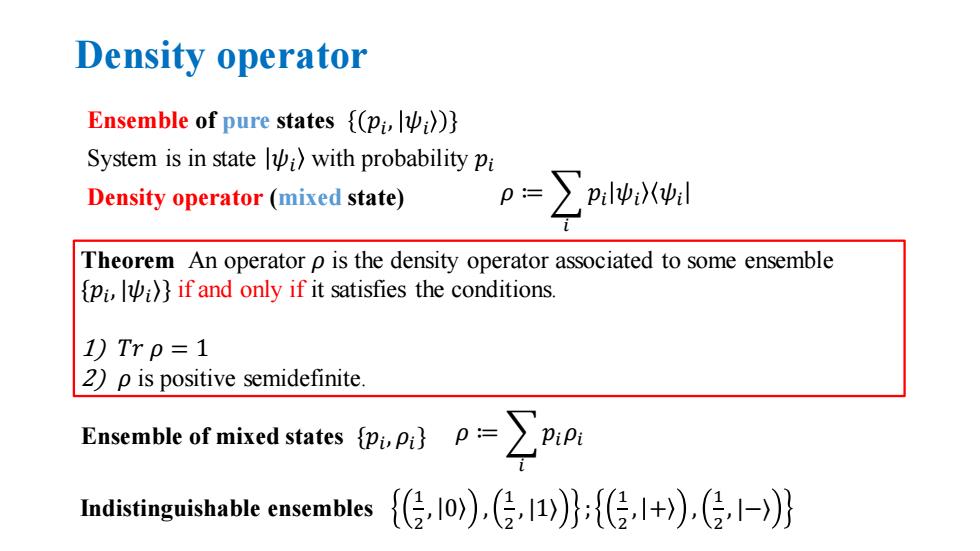
Density operator Ensemble of pure states {(pi,)} System is in state)with probability pi Density operator (mixed state) iv:wil Theorem An operator p is the density operator associated to some ensemble pi,i)}if and only if it satisfies the conditions. 1)Trp=1 2)p is positive semidefinite. Easemble of mixed states Indistinguishable ensembles {1o),(任11}:(经,+).(经1-}
Density operator Ensemble of pure states 𝑝𝑖 , 𝜓𝑖 } Density operator (mixed state) Theorem An operator 𝜌 is the density operator associated to some ensemble {𝑝𝑖 , |𝜓𝑖 ⟩} if and only if it satisfies the conditions. 1) 𝑇𝑟 𝜌 = 1 2) 𝜌 is positive semidefinite. Ensemble of mixed states {𝑝𝑖 , 𝜌𝑖 } 𝜌 ≔ 𝑖 𝑝𝑖𝜌𝑖 𝜌 ≔ 𝑖 𝑝𝑖 𝜓𝑖 𝜓𝑖 System is in state 𝜓𝑖 with probability 𝑝𝑖 Indistinguishable ensembles 1 2 , 0 , 1 2 , |1⟩ ; 1 2 , + , 1 2 , |−⟩
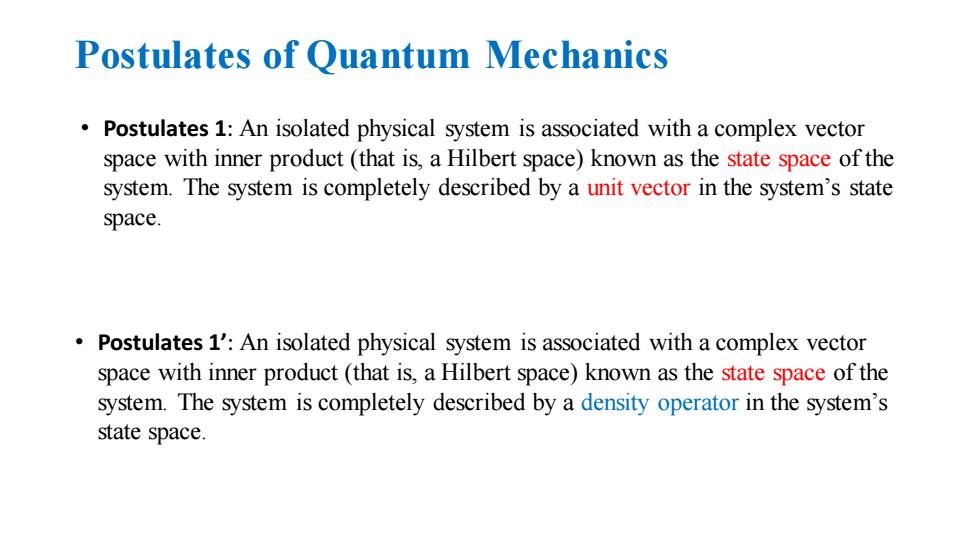
Postulates of Quantum Mechanics Postulates 1:An isolated physical system is associated with a complex vector space with inner product(that is,a Hilbert space)known as the state space of the system.The system is completely described by a unit vector in the system's state space. Postulates 1':An isolated physical system is associated with a complex vector space with inner product(that is,a Hilbert space)known as the state space of the system.The system is completely described by a density operator in the system's state space
Postulates of Quantum Mechanics • Postulates 1: An isolated physical system is associated with a complex vector space with inner product (that is, a Hilbert space) known as the state space of the system. The system is completely described by a unit vector in the system’s state space. • Postulates 1’: An isolated physical system is associated with a complex vector space with inner product (that is, a Hilbert space) known as the state space of the system. The system is completely described by a density operator in the system’s state space
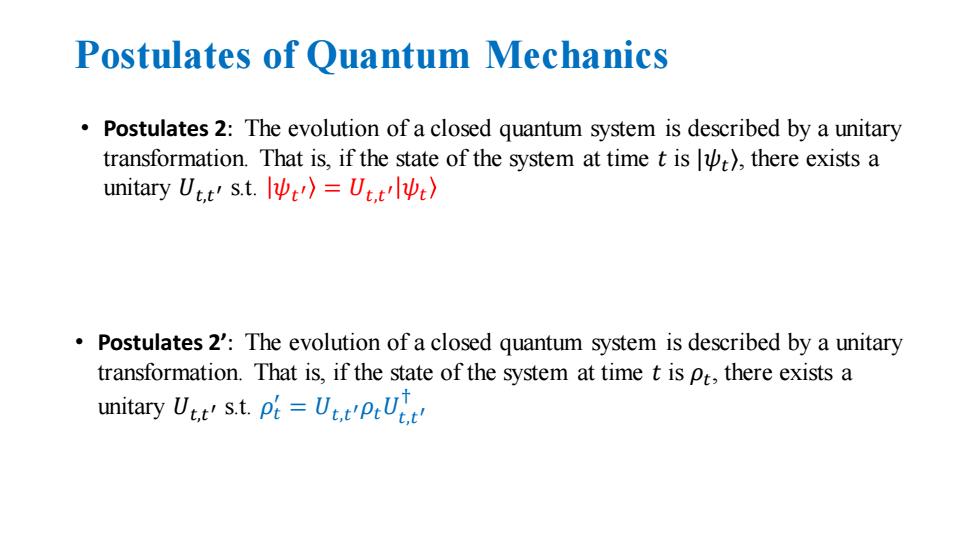
Postulates of Quantum Mechanics Postulates 2:The evolution of a closed quantum system is described by a unitary transformation.That is,if the state of the system at time t ist),there exists a unitary Utt's.t.=U) Postulates 2':The evolution of a closed quantum system is described by a unitary transformation.That is,if the state of the system at time t is pt,there exists a uitary Us.t.P=UPU
Postulates of Quantum Mechanics • Postulates 2: The evolution of a closed quantum system is described by a unitary transformation. That is, if the state of the system at time 𝑡 is |𝜓𝑡 ⟩, there exists a unitary 𝑈𝑡,𝑡 ′ s.t. 𝜓𝑡 ′ = 𝑈𝑡,𝑡 ′ 𝜓𝑡 • Postulates 2’: The evolution of a closed quantum system is described by a unitary transformation. That is, if the state of the system at time 𝑡 is 𝜌𝑡 , there exists a unitary 𝑈𝑡,𝑡 ′ s.t. 𝜌𝑡 ′ = 𝑈𝑡,𝑡 ′𝜌𝑡𝑈𝑡,𝑡 ′ †